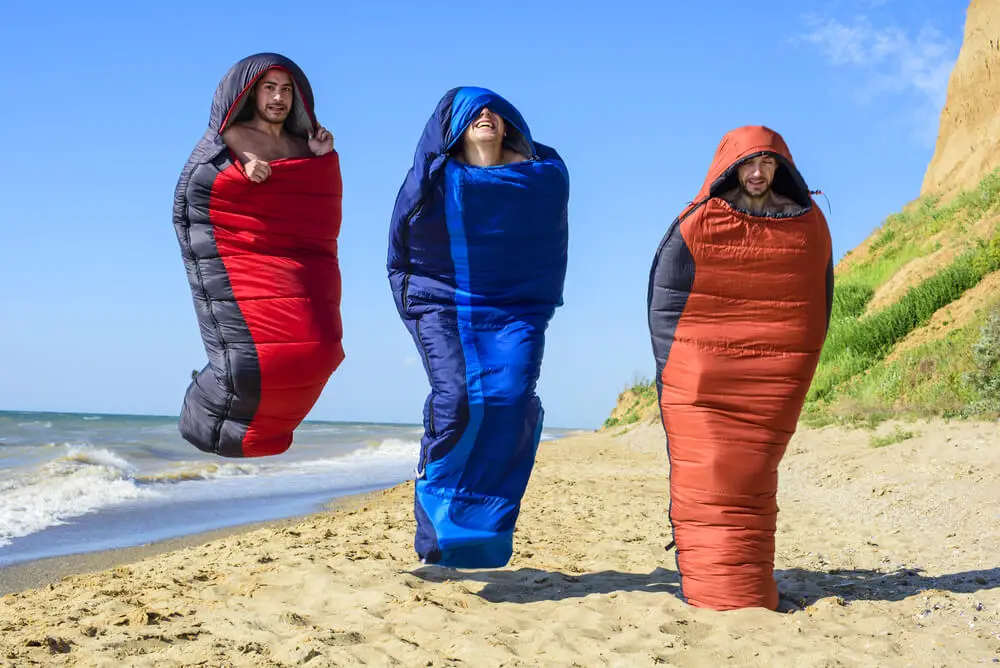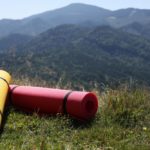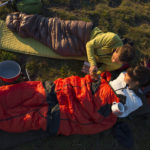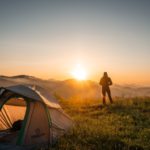Before heading out on any camping trip, it’s essential to make sure you go through the checklist of essentials. While every camper needs necessities such as flashlights and first aid supplies, many people find themselves wondering: do you need a sleeping bag for camping?
While a sleeping bag can make for a cozier, more comfortable camping experience, you don't necessarily need to take one on your trip. Sleeping bags are even less important when sleeping in warm, forgiving climates. As long as you bring something to keep yourself covered and insulated, you'll be safe in any weather.
Read on to learn more about camping without a sleeping bag and alternative options that you can use to keep warm when temperatures drop.
More...

Table of Contents
Deciding to Ditch the Sleeping Bag
Contrary to popular belief, a sleeping bag isn’t necessarily a must-have in your outdoor survival kit. In fact, some campers find sleeping bags to be more trouble than they’re worth. Sleeping bags come alongside drawbacks such as:
- You’ll pay high costs for quality construction, material, and insulation.
- Bags are bulky, heavy, and take up valuable storage space.
- Sealed sleeping bags often overheat and offer poor temperature control.
- You’ll have restricted movement during the night.
- Some bags can be challenging to clean due to size or care instructions.
Many experienced campers choose to forgo a sleeping bag in favor of other more convenient sleeping arrangements. In warmer weather, some may use hammocks, while others simply lay on the forest floor. However, remember that the ground can be a heat sink, even in warm weather, and can cause symptoms of cold stress.
What Can I Use Instead of a Sleeping Bag?
If you plan on camping without a sleeping bag, you should still avoid exposing yourself to the elements. It’s best to use some sort of alternative to keep yourself warm and insulated. Here, we’re going to go over some of the best sleeping bag alternatives to use on your next camping trip.
Sleeping Bag Liners
Many people who use sleeping bags in cold climates choose to improve insulation by adding a liner. You can use a sleeping bag liner without its dedicated sleeping bag for a more compact, lightweight sleeping solution.
The amount of protection a liner offers will depend on the material used:
- Silk and Cotton: These materials both offer minimal insulation and maximum breathability.
- Microfiber: Soft and easy to wash, microfiber liners offer moderate protection from the cold.
- Wool or Merino Wool: Wools offer moderate to high insulation levels and the added benefit of natural odor resistance.
- Thermal synthetics: Synthetic fabrics are often the warmest, as they’re lab-made to trap heat and keep out cold. ThermoLite is one of the warmest synthetics, and it isn’t as bulky as the alternatives.
Quilts and Blankets
Blankets are another excellent way to keep warm without relying on a sleeping bag. They offer a high degree of heat control, as you can add or remove blankets as needed to reach the perfect temperature at night.
Like sleeping bag liners, different blankets offer varying degrees of insulation based on material. Cotton and silk blankets tend to be lightweight, while wool and fleece offer moderate warmth. The warmest blankets contain synthetics such as acrylic, polyester, or nylon.
Air Mattresses
Whether you use a sleeping bag liner, a blanket, or choose to sleep uncovered, you should always place an insulator between you and the ground. Otherwise, you may lose heat faster than anticipated.
If you don’t use a padded sleeping bag for insulation, an air mattress makes an excellent alternative. Not only will it keep you off the ground, but it will also provide cushioning for sore joints and muscles. When using an air mattress, don’t forget to bring a compatible pump and an energy source, if necessary.
Mattress Pads
A thick mattress pad can also provide plenty of insulation from the ground when camping outdoors. As with air mattresses, a mattress pad will also offer extra cushioning, making it a popular choice for campers with back, hip, or joint issues.
Keep in mind that while they might make a practical and comfortable insulator, most mattress pads don’t pack light. They are bulkier and heavier than air mattresses, as they don’t deflate and roll down. You may want to reserve mattress pads for campground or car camping.
Warm Clothing
If nothing else, you should make sure to wrap yourself in warm, well-insulated clothes before you fall asleep to avoid losing too much body heat. Clothing is also a good alternative if you lose your primary source of insulation, such as your sleeping bag or blanket.
Always make sure to bring some extra warm clothes with you on your camping trip in case you need them when temperatures drop. It’s a good idea to include insulated garments to cover your body from head-to-toe, including:
- Gloves or mittens
- A warm hat
- Thick socks
- Long underwear or insulated pants
- A thermal or down jacket
When to Use a Sleeping Bag?
Plenty of campers ask: do you need a sleeping bag for camping?
While the answer is usually no, in some cases, it may be best to invest in a suitable sleeping bag to keep yourself warm. Even though they can be restricting, sealed sleeping bags offer some of the best insulation in cold environments.
Sleeping bags trap more body heat than quilts or blankets and help insulate you from the ground. Some specially made sleeping bags can help protect you from dangerously cold temperatures so that you don't have to worry about issues such as hypothermia or frostbite.
Finding the Right Sleeping Bag
If you do find yourself needing a sleeping bag, you must choose the right one to fit your camping needs.
A quality sleeping bag can be a significant investment, and you don’t want to choose something that will ruin your sleep quality after a long day outdoors. Read on to learn more about how to find the right sleeping bag for you.
Temperature Rating and Insulation
All sleeping bags come with a temperature rating that tells you when they’re safe to use. When in doubt, it’s always best to look for a bag with a lower rating than you need. The most common temperature ratings include:
- Summer sleeping bags for nights 30°F or higher.
- 3-Season sleeping bags for nights between 15°F and 30°F.
- Winter sleeping bags for below 15°F.
Bag Shape
Different bag shapes allow for varying levels of mobility and numbers of occupants. The most common sleeping bag shapes include:
- Rectangular bags: These allow for the most stretching and mobility.
- Mummy bags: A snug fit gives superior insulation but reduced mobility.
- Barrel bags: Also known as a modified mummy bag, this style insulates while providing a limited degree of motion.
- Double bags: A double sleeping bag can be used alone for an improved range of motion or with a partner.
Saving Money on a Sleeping Bag
If your main issue with a sleeping bag is cost, you can find some low-cost options that will allow you to sleep in comfort without breaking the bank. Here, we’re going to go over some money-saving options to consider when looking for a quality sleeping bag at an affordable price.
Rent a Sleeping Bag
If you don’t want to purchase your own sleeping bag, you can rent one for your trip at a fraction of the price. Some campgrounds and outdoor stores offer sleeping bag rental services for campers who don’t have sleeping gear.
Always check to ensure that any sleeping bag rental service you use has thorough cleaning procedures in place before placing a booking. As an added precaution, you may want to bring your own liner to add an extra layer of protection.
Check Online Marketplaces
You may be able to find a discount on a quality sleeping bag brand by searching your local online marketplace ads. Sites for selling goods are all goldmines for gently used camping gear. Try:
- Facebook Marketplace
- eBay
- Craigslist
You can also post wanted ads to your social media to see if any friends or family might have a spare bag that they’d be willing to sell you for a reasonable price. At the very least, you might find an extra bag to borrow for your trip.
Frequent Outdoor Store Sales
Large outdoor stores such as REI or Columbia frequently have sales where last season’s gear goes on sale. These sales are the perfect opportunity to stock up on camping goods such as sleeping bags for a fraction of the cost.
Check your favorite brands online or in-store to see when they go on sale. You may want to sign up for their newsletter or mailing list to get notifications whenever the sleeping bag you want goes on sale.
So, Do You Need a Sleeping Bag for Camping?
Don't worry if you don't have a sleeping bag in your camping arsenal. As long as you have some way to stay warm and insulated in cold temperatures, you don't necessarily need a sleeping bag for camping. There are plenty of alternatives that can keep you safe even in cold weather.
- Are Merrell Shoes Good? – An Unbiased Review of Merrell Footwear - December 9, 2023
- Where Are Merrell Shoes Made? - December 9, 2023
- Camping in 40-degree Weather: Tips and Tricks - September 25, 2023



![How to Roll a Coleman Sleeping Bag? [Quick Guide] How to Roll a Coleman Sleeping Bag? [Quick Guide]](https://grandcircletrails.com/wp-content/uploads/2022/03/How-to-Roll-a-Coleman-Sleeping-Bag-1-150x150.jpg)
![How to Make Toast While Camping? [Methods You Need To Try] How to Make Toast While Camping? [Methods You Need To Try]](https://grandcircletrails.com/wp-content/uploads/2022/07/How-to-Make-Toast-While-Camping-150x150.jpg)

![Best Wood for Campfires [Everything You Need To Know] Best Wood for Campfires [Everything You Need To Know]](https://grandcircletrails.com/wp-content/uploads/2021/11/Best-Wood-for-Campfires-1-150x150.jpg)